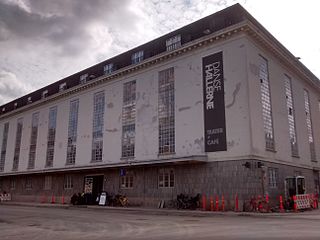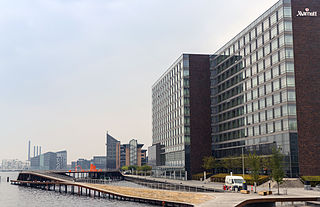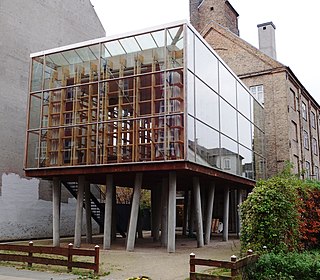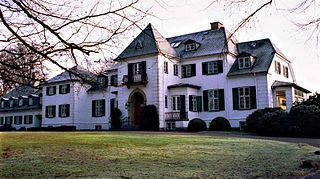
The David Collection is a museum of fine and applied art in Copenhagen, Denmark, built around the private collections of lawyer, businessman and art collector C. L. David. The building at Kronprinsessegade 30 which houses the museum used to be the private home of the founder and was originally bought in 1810 by his great-grandfather, C. N. David, but sold again in 1830. In 1917 it was re-acquired by C. L. David, who took up residence in it but also made his collection available to the public at the upper floors of the building. Admission is free.
Amager Øst is one of the 10 official districts of Copenhagen Municipality, Denmark. It encompasses the part of Copenhagen located on the island of Amager, east of the major shopping street Amagerbrogade.Prior to an administrative reform in 2006–08, the district was known as Sundbyøster.

Dorte Mandrup-Poulsen is a Danish architect. Founder and Creative Director of the architectural practice Dorte Mandrup Arkitekter A/S that has approximately 60 employees. The practice is based in Copenhagen, Denmark and has designed several internationally acclaimed buildings.

Bakkehuset is a historic house museum on Rahbeks Allé in the Frederiksberg district of Copenhagen, Denmark. Dating from the 1520s, it has served a number of functions over the years, including as a farmhouse, inn, private home, psychiatric hospital and orphanage. It is particularly associated with the Danish Golden Age when it was owned by Knud Lyne Rahbek and his wife, Kamma Rahbek, used it as a venue for her salons.

Tap E is a former storage building of a bottling plant in the Vesterbro district of Copenhagen, Denmark, part of Carlsberg's historic brewery site which is now known simply as the Carlsberg area. After the production of beer in the area stopped in 2009, the listed building has been taken unto use as a cultural venue which houses both a centre for modern dance, Dansehallerne, and Fotografisk Center, a gallery and digital laboratory dedicated to fine art photography.

Refshaleøen is a former industrial site in the harbor of Copenhagen, Denmark, originally on a separate island but now annexed to the larger island of Amager. For more than a hundred years, it was home to the shipyard Burmeister & Wain, which closed in 1996.

Kalvebod Brygge is a waterfront area in the Vesterbro district of Copenhagen, Denmark. The name also refers to a section of the Ring 2 ring road which follows the waterfront from Langebro in the north to the H. C. Ørsted Power Station in the south. The area is dominated by office buildings, Tivoli Conference Center, several hotels and the shopping centre Fisketorvet.

Kedelhallen is a cultural and sports venue in the Frederiksberg district of Copenhagen, Denmark. The buildings were previously part of Frederiksberg Incineration Plant but were adapted for their current use in 2001.

Steinfass House is a listed house overlooking Christianshavn Canal in the Christianshavn neighbourhood of Copenhagen, Denmark. It is now part of the Sofiegården hall of residence.

Østerfælled Torv is a mixed-use development surrounding a public space by the same name in the former grounds of Østerfælled Barracks in the Østerbro district of Copenhagen, Denmark. It is a result of a redevelopment of the site in the 1990s which preserved many of the old buildings, now used for retail and commercial space as well as cultural facilities, combining them with new apartment buildings.

Carlsberg Museum, situated next to the former home of Carl Jacobsen in the Carlsberg area of Copenhagen, Denmark, was the first home of his sculpture collection, now on display in the Ny Carlsberg Glyptotek in the city centre. The building consists of a total of 20 galleries accumulated between 1892 and 1895 through a series of extensions to designs by Vilhelm Dahlerup and Hack Kampmann. It now serves as a venue for conferences, receptions and other events.

Palace Hotel is a residential hotel on the eastern side of City Hall Square in Copenhagen, Denmark. Influenced by the Art Nouveau style, the red brick building was designed by Anton Rosen and completed in 1910.

Lorry is a former entertainment venue in the Frederiksberg district of Copenhagen, Denmark. Its history as an entertainment venue goes back to 1834 when the country house Enighedslyst was converted into a tea garden. The name refers to a later owner, Frederik Laurentius Feilberg, who was popularly known as Lorry. The listed building complex now houses TV2/Lorry, TV2's local news station for the Copenhagen area; a small theatre, Riddersalen; and a café.

Falkoner Centre is a hotel and conference complex located in the Frederiksberg district of Copenhagen, Denmark. It mainly consists of Scandic Falconer Hotel & Conference Centre. It has two venues which play host to both conferences such as concerts and shows.

Holmbladsgade is one of the most lively streets in the Amagerbro district of Copenhagen, Denmark, connecting Amagerbrogade to Strandlodsvej on the east coast of Amager. The surrounding neighbourhood is variously referred to as Holmbladsgadekvarteret, Amagerbro or Sundby North.

Vega is a regional entertainment centre on Vesterbro in Copenhagen, Denmark. It was inaugurated in 1996 as part of the city's agenda as European Capital of Culture.

Kvarterhuset, located just off Holmbladsgade, is a culture house run by Copenhagen Municipality in the Amager district of Copenhagen, Denmark. The building is a former warehouse which was adapted and expanded for its current use by Dorte Mandrup prior to its opening in 2001. It contains the local Sundby Library as well as other facilities for the local community.
Kastrup Strandpark is a waterfront park on the east coast of Amager in Copenhagen, Denmark. It is situated between the larger Amager Strandpark to the north and the National Aquarium Denmark and the Scanport development to the south.

Rolighed is a former country house in Skodsborg, Rudersdal Municipality, approximately 16 km north of Copenhagen, Denmark. The history of the property dates back to 1780 but the current house is from 1927. Formerly associated with the Conservative People's Party, it now houses Mærsk's Center of Leadership.

Josty is a historic restaurant venue situated inside Frederiksberg Gardens, off Pile Allé, in the Frederiksberg district of Copenhagen, Denmark. It is now mainly operated as an event venue but also has a small number of hotel rooms and operates a café on the Veranda facing the park in the summer time. The current building is from 1899 but the place traces its history back to a pastry café which opened at the site in 1824.


















